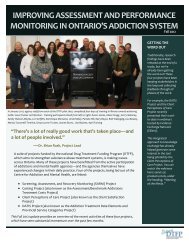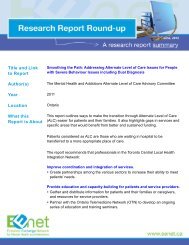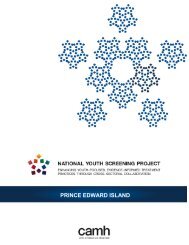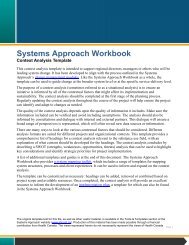Implementation of Early Psychosis Intervention Program ... - EENet
Implementation of Early Psychosis Intervention Program ... - EENet
Implementation of Early Psychosis Intervention Program ... - EENet
You also want an ePaper? Increase the reach of your titles
YUMPU automatically turns print PDFs into web optimized ePapers that Google loves.
4Key MessagesSurvey Participationo The rate <strong>of</strong> participation was very high, with responses received from 56 EPI program sites,including 52 with the young person experiencing psychosis as the client, 3 with the family asthe client, and one with a regional coordination mandate. The results provide richinformation for exploring program stakeholder perceptions about Standards implementation,challenges and facilitators to implementation, and potential opportunities for practiceimprovement.<strong>Early</strong> <strong>Psychosis</strong> <strong>Intervention</strong> <strong>Program</strong> Pr<strong>of</strong>ileo The 52 sites serving the young person experiencing psychosis varied widely, with budgetsfrom $41,000 to $2.6 million, clinical staff from 1 to 14 full time equivalent staff (FTEs), andtotal caseloads from 5 to 342. The programs were sponsored by both hospital and communityagencies. Most were implemented after the government released the provincial EPIframework in 2004 and new EPI program funding was <strong>of</strong>fered.o Caseload size per clinical staff varied from 6 to 48, with a mean <strong>of</strong> 19. In internationalresearch and policy, caseloads <strong>of</strong> 10 to 15 are suggested, and in the present survey lack <strong>of</strong>staff time was <strong>of</strong>ten noted as a challenge to implementing the Standards. This especiallyrelated to developing referral networks, engaging psychiatry and primary care, andconducting proactive outreach to clients and families.o EPI is a comprehensive service model that may be delivered by a dedicated, specialized teamor by a small staff that accesses additional support for clients from other providers. Thesurvey identified 21 “small” sites, with catchment area populations <strong>of</strong> less than 100,000 and1 to 2 clinical staff. While small sites reported reasonable compliance with the Standards,challenges were noted in accessing psychiatric and general medical care, having time foroutreach and education, and addressing the full range <strong>of</strong> client psychosocial needs.Standards <strong>Implementation</strong>o The assessed practices pertained to six Standards and multiple elements within eachStandard. Perceived level <strong>of</strong> implementation varied across the elements. In general,implementation was higher where programs have more control over service practices (e.g.,medications protocols, relapse prevention protocols, response times after client referral), andlower where programs are more reliant on other community services and supports(developing referral networks, working with inpatient units, linking clients with follow-upsupports at discharge).o <strong>Program</strong>s were least likely to fully implement Standards related to public education and earlyidentification referral network development. Challenges implementing these elements havebeen reported in other jurisdictions. Outreach to referral sources requires time andpersistence, and may receive a lower priority than clinical care when staff time is a concern.
















